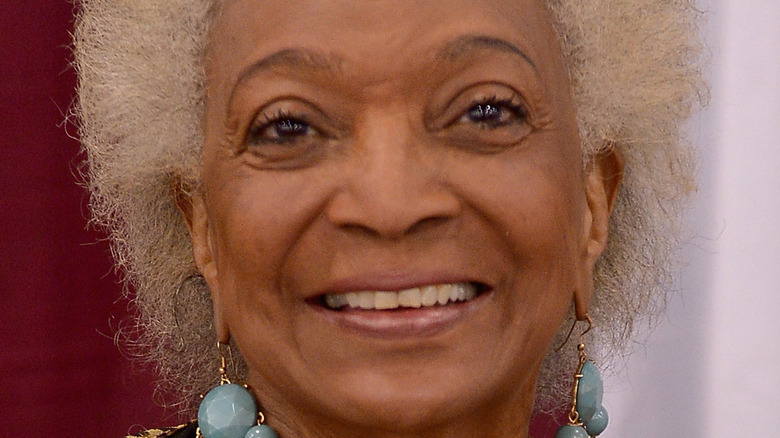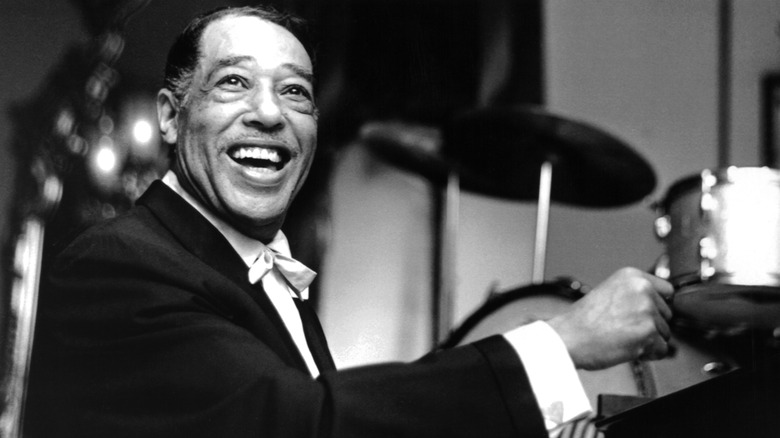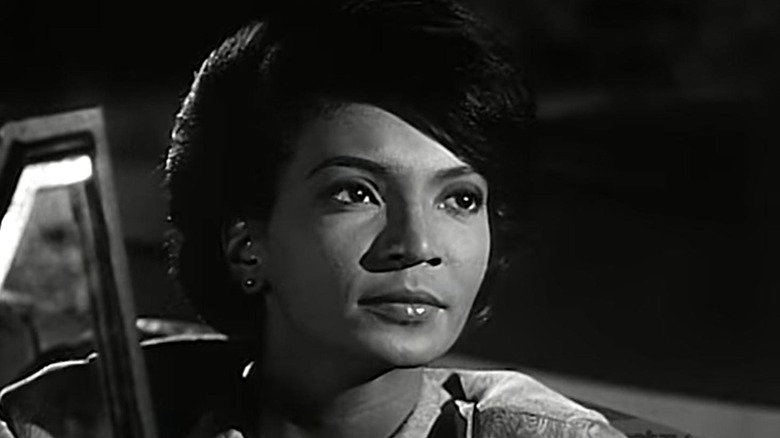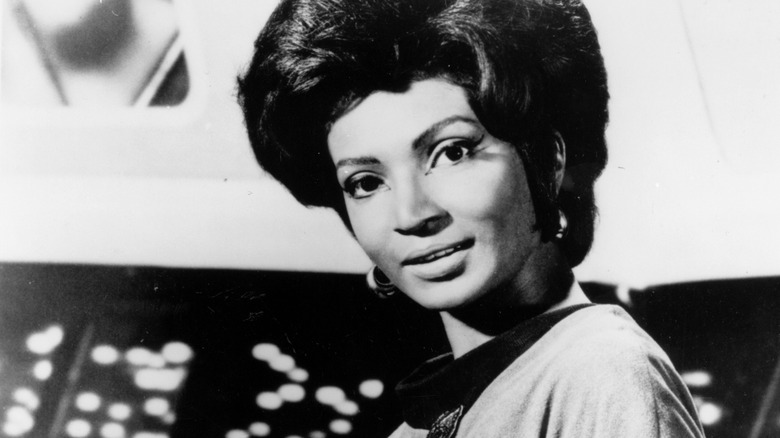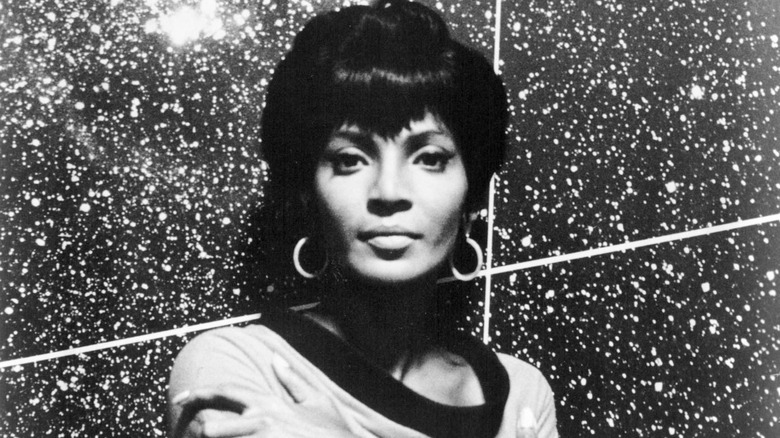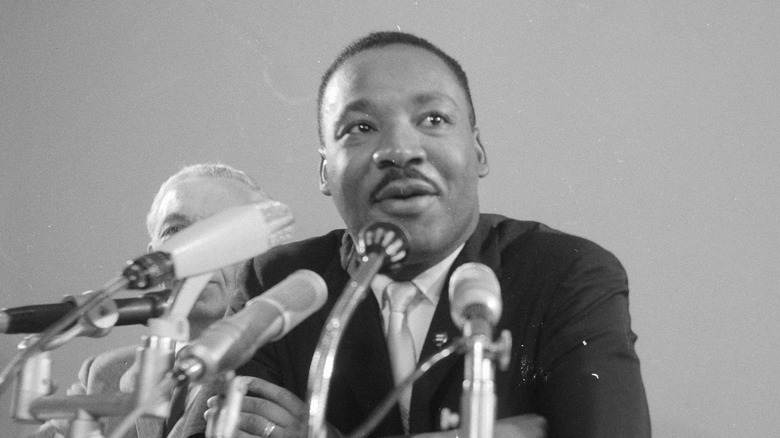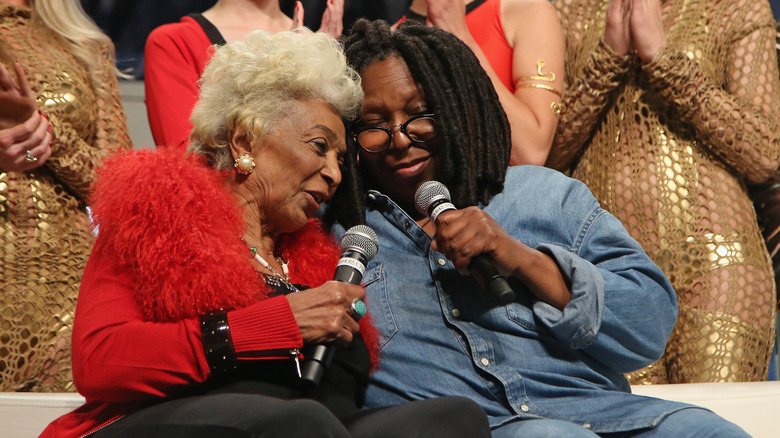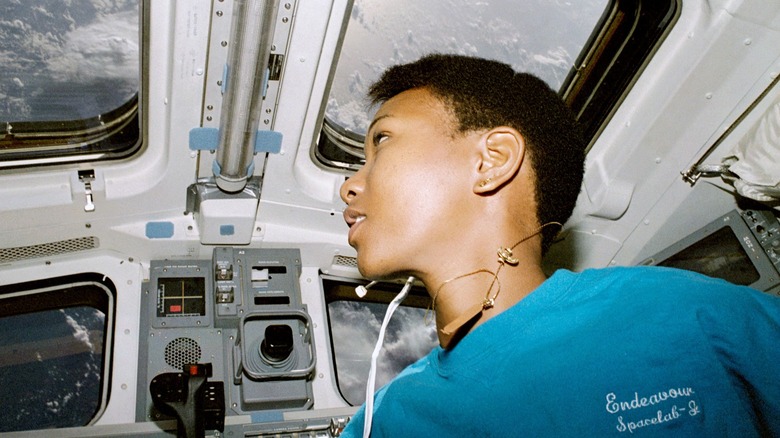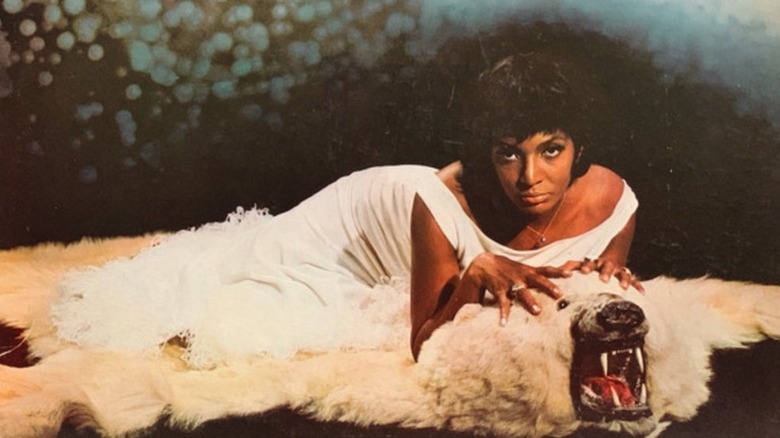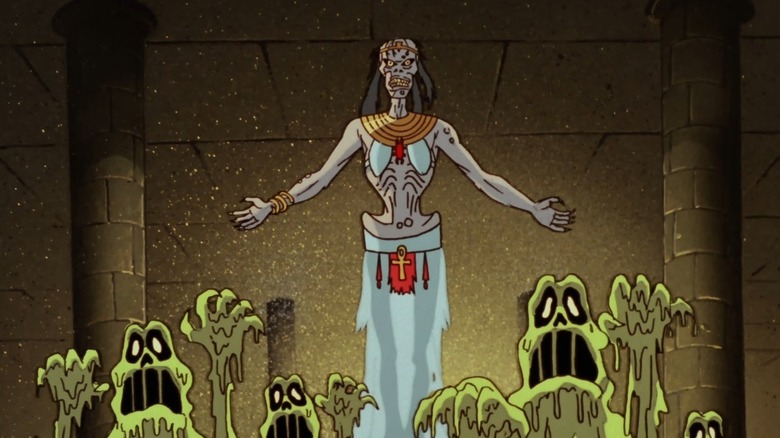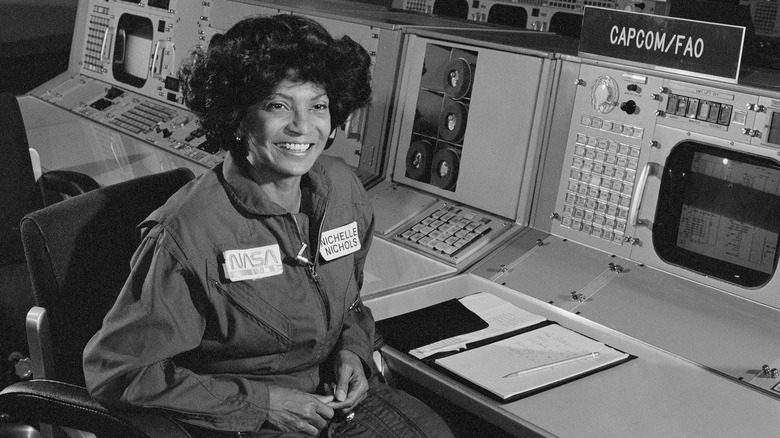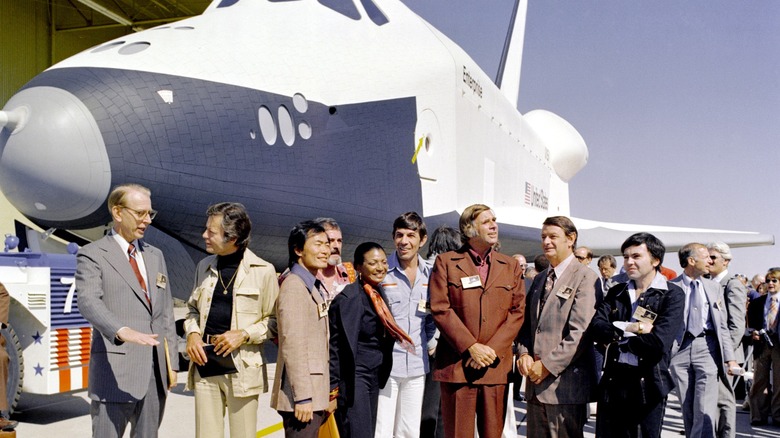The Untold Truth Of Nichelle Nichols
Nichelle Nichols was a true icon of 20th-century pop culture. An actress, singer, dancer, author, and real-life space travel advocate, she inspired a generation of people to find their place in the world (and off it), showing the impact that diverse representation in popular media can have. Despite passing away from natural causes (via Time), her legacy lives on in the boundaries she redefined and the inspiration she gave to Black women in the latter days of the American civil rights movement. Nichols accomplished a great deal in her 89 years. In the words of her son Kyle Johnson, "Hers was a life well lived and as such a model for us all."
Nichols was best known for playing the character Uhura on "Star Trek," a role that came to define much of her life. Zoe Saldana, who played a different version of the same character, spoke fondly of Nichols in an Instagram post, mentioning how the actress had an infectious energy and could convince you to believe that "anything was achievable, if you put your heart into it." It's this same energy that Nichols brought to her work as an ambassador for NASA at the height of its popularity in the 1970s when she helped to recruit astronauts. In a statement, NASA administrator Bill Nelson praised her science advocacy work, describing her as a "dear friend to NASA." While she may have been best known for "Star Trek," Nichelle Nichols was far more than just an actress.
Her career began on the stage, not the screen
Years before she appeared on television, Nichelle Nichols' first break in acting came in the form of musical theater, and her first big role was the character Hazel Sharpe in the original cast of the stage musical "Kicks and Co." (via Broadway World). Opening in June 1961, "Kicks and Co." was written by Oscar Brown Jr., premiering in Chicago. As Chicago Sun-Times explains, the show was predicted to be a hit before it even opened, and critics expected it to open in Chicago before heading to Broadway. Unfortunately, the show received mixed reviews — there was praise for the musical composition but criticism for the show's apparent lack of direction. In the end, "Kicks and Co." only lasted for four performances.
While this may have been a rocky start to her acting career, it didn't set Nichelle Nichols back. She went on to play roles in other stage shows afterward, according to the Arkansas Times, including playing the lead role in a production of "Carmen Jones." As an adaption of the opera "Carmen" by Georges Bizet, Nichols' casting proved that she excelled as a singer on stage. Singing was one of her true passions as a performer, and one that she held on to throughout her career.
She was a keen singer
As well as roles in theater, Nichelle Nichols' early career saw her spending time on stage as a vocalist, singing with a two octave range. New Mexico Entertainment recounts the story of how jazz legend Duke Ellington saw Nichols performing in a club and decided to recruit her as a vocalist for his band. Still early in her career, Nichols excitedly called her parents, both of whom were big fans of Ellington's music, to say, "Guess who I'm performing with?" She even got the chance to introduce her mother to Ellington over a phone call — at the request of Ellington himself. As a jazz singer, Nichols spent time in the 1960s on tour with Duke Ellington's band and also with Lionel Hampton, another popular jazz bandleader at the time (via AllMusic).
Even after she accepted her acting role on "Star Trek," Nichols held on to her love of song. Two episodes of the original series, "Charlie X" and "The Conscience of the King," feature scenes with her singing. Strangely though, these were the only two times that she sang on "Star Trek," despite later opportunities to do so. The notoriously unsatisfying movie "Star Trek V" features Uhura performing a song and dance routine to cause a distraction. As Heavy mentions, however, while the provocative dancing was entirely Nichelle Nichols' performance, it wasn't actually her singing voice.
Nichelle Nichols worked with Gene Roddenberry before Star Trek
"Star Trek" is the brainchild of Gene Roddenberry, and while it may be the TV show which made him famous, he was already an established television writer. Before "Star Trek," Roddenberry's first TV show was a series called "The Lieutenant." Set in California, it was a military drama following the lives of a group of U.S. Marines based at Camp Pendleton in the midst of the ongoing Cold War.
The show turned out to be Roddenberry's introduction to Nichelle Nichols when she was cast in a minor role. Nichols featured as the character Norma Bartlett in the episode "To Set It Right." The story sees William Rice, the titular Lieutenant, have to confront the issue of racism in his unit. As The History Makers notes, this was Nichols' first appearance on television, but disappointingly, it wouldn't actually be aired until decades later, during the 1990s! According to Laughing Squid, the choice to deal openly with racial issues in 1960s America led to the series being canceled. Even so, "The Lieutenant" was the stepping stone that led both Roddenberry and Nichols to make "Star Trek." At the time, neither could possibly have imagined they'd one day be world famous.
Lt. Uhura was a Black pioneer of science fiction
The first episode of "Star Trek" aired in 1966 with Nichelle Nichols playing Lieutenant Nyota Uhura, the communications officer on the bridge of the Starship Enterprise. From a 21st-century perspective, her role may seem unremarkable, but at the time, it was almost entirely unprecedented. As The Wall Street Journal notes, she was one of the first Black women to be cast in a role other than the stereotype of a maid or a nanny. In an interview with Television Academy Foundation, actress Whoopi Goldberg credits Uhura as giving Black women a place in the future, describing her importance as "earth-shattering."
Lieutenant Uhura, as Yes! Magazine notes, wasn't actually the first Black woman in 20th-century science fiction, but she was certainly one of the most noteworthy. The first Black women to appear in sci-fi had menial roles as maids and housekeepers, and while the 1940 movie "Son of Ingagi" features a Black woman as the scientist Dr. Helen Jackson, "Star Trek" stood out because it was on television, broadcast directly into homes across America and elsewhere. Uhura rapidly became a fan favorite character, and with the civil rights movement in full swing, her name was subtly appropriate too. B**** Media explains that the name "Uhura" was chosen by Roddenberry and Nichols, based on the Swahili word "uhuru," which means "freedom." The character's first name, Nyota, is also from Swahili, where it's the word for "star."
She appeared on the cover of Ebony magazine
Uhura was such a high-profile character that Nichelle Nichols rapidly became a star. In 1967, she was featured on the cover of Ebony Magazine, one of America's leading showcases of Black culture. As Ebony Magazine notes 50 years later, "Star Trek" came out at a time when it was particularly dangerous to be Black, and Nichols' role in "Star Trek" was an inspiration for young girls of all skin tones. The feature in Ebony Magazine (via My Star Trek Scrapbook) lauds the show, with a tongue-in-cheek line calling it "a triumph of modern-day TV over modern-day NASA."
The article itself talks about Nichols' bright and bubbly personality and mentions her previous work as a singer — but it also makes a few interesting points about how, for its time, "Star Trek" was quite a progressive show. Among other things, it notes that the communications officer role had originally been intended for a man before it was given to Nichols, highlighting the theme of equality that "Star Trek" has so often commented on. It's worth noting that this is also something that Nyota Uhura has in common with another iconic science fiction character — Ellen Ripley, who the Straits Times explains was also originally written as a male role for the "Alien" series.
Martin Luther King was Nichols' biggest fan
It's a famous story — Nichelle Nichols was convinced to remain on "Star Trek" by none other than the Reverend Dr. Martin Luther King Jr., but some of the story's more charming and impactful details are often left out. Chief among them was the fact that Dr. King and his family were avid viewers of "Star Trek." In fact, it was the only show that King's children were allowed to stay up past their bedtime to watch. As The Chronicle of Higher Education recounts, King was delighted to meet Nichols, introducing himself with the words, "I am your best fan, I am your biggest fan!"
Nichols recounts the remarkable story in an interview for Television Academy Foundation. At the time, she planned to accept a stage role and had already handed her resignation letter to Gene Roddenberry, though he hadn't accepted it yet, asking her to take the weekend to think it over. That same weekend, Nichols met King. His enthusiasm for Uhura's importance was what convinced her to stay with "Star Trek," realizing that just by appearing on screen, she was doing much more for the civil rights movement than she'd realized. Initially though, Nichols' feelings were mixed. She mentions feeling angry and overwhelmed by the responsibility, asking herself, "Why me?" By that Monday, however, she'd made her choice to stay, and she returned to Roddenberry to retract her resignation, only to find that he'd already torn up her letter.
Uhura inspired actress Whoopi Goldberg
Martin Luther King's words to Nichelle Nichols were insightful ones. Elsewhere in America, her presence had not gone unnoticed, and her character Uhura was already proving inspirational. According to the book "Geek Heroines," actress Whoopi Goldberg's first reaction to seeing Nichols on TV was to run and tell her family, "I just saw a Black woman on television, and she ain't no maid!"
It was "Star Trek" that inspired Goldberg to pursue her long career in acting, eventually taking a role in "Star Trek: The Next Generation." In an interview with Makers, Goldberg mentions meeting Nichelle Nichols and having the chance to tell her about the impact she'd made — after seeing Nichols on screen, Goldberg knew she could be anything she wanted to be. In a Television Academy Foundation interview, Goldberg talks about her need to get involved with "Star Trek" after hearing that LeVar Burton had been cast, but no one took her seriously at first. At the time, it was extremely unusual for a movie actor to take a role on a TV show. She ended up speaking directly to Gene Roddenberry, explaining why Star Trek was so important to her — that before Lieutenant Uhura, Black people effectively didn't exist in any visions of the future. "Star Trek" was a futuristic world of unity and equality, and Whoopi Goldberg wanted to be a part of that for others. Roddenberry ended up creating the character Guinan specifically for Goldberg.
Uhura inspired astronaut Mae Jemison
In 1987, Dr. Mae Jemison was recruited to be the first African American woman to go into space. As NASA mentions, she was a brilliant student when she was young, going to college when she was just 16 and earning two degrees. One of her largest sources of inspiration was "Star Trek," which drove her to become a real-life astronaut. According to the book "Geek Heroines," watching "Star Trek" as a child was what fostered Jemison's love of space, and seeing Uhura was what made her realize she could pursue her dream. Jemison would later meet Nichelle Nichols at a "Star Trek" fan convention, telling her, "You gave me and others permission to be in the room."
NASA's space mission STS-47 took Jemison into orbit in 1992 aboard the Space Shuttle Endeavour (unfortunately not the Enterprise, though that would've been quite poetic). As the National Women's History Museum notes, Jemison later appeared in an episode of "Star Trek: The Next Generation" after being invited to do so by LeVar Burton. She played a cameo role in the episode "Second Chances," becoming the first real astronaut to appear on the show, which inspired her as a child. Her story highlights exactly how prescient Martin Luther King's words were in the 1960s. If Nichelle Nichols hadn't appeared on "Star Trek," Mae Jemison might never have become an astronaut.
Nichelle Nichols recorded two music albums
While her career shifted away from musical theater, Nichelle Nichols never lost her passion for singing. During her life, she released two albums of music. The first, "Down to Earth," was recorded while "Star Trek" was being made. The album was made together with jazz arranger Gerald Wilson, and a review on AllMusic describes her as a "formidable" vocalist in songs ranging from upbeat to slow and soulful.
Later on, Nichelle Nichols returned to the studio to produce a second album, "Out Of This World." The AllMusic listing calls it a mixture of Jazz pop and spoken word (it includes a poem and an interview), and with a picture of Nichols in character as Uhura on the cover, it feels like a tribute to her time on "Star Trek" — and also to its creator Gene Roddenberry. It's deeply significant that this album was released in 1991, the year in which Roddenberry passed away (via The New York Times). The second track on "Out Of This World" is a song called "Gene," which Nichols wrote for Roddenberry while his health was failing in the early 1990s (per Variety). She later sang the song at his funeral.
She once played a Batman villain
Following the end of the original run of "Star Trek" on TV, Nichelle Nichols reprised her role as Uhura in "Star Trek: The Animated Series." The show was every bit as outlandish, campy, and fun as the live-action original and even saw Uhura taking command of the Enterprise during the episode "The Lorelei Signal." This wouldn't be the last of Nichols' ventures into animated shows, however. Matt Groening's comedy shows are well known for their occasional celebrity guests, and Nichelle Nichols has made cameo appearances as herself in two of them, appearing in an episode of "The Simpsons," "Simple Simpson," and in the "Futurama" episode "Anthology of Interest I."
One of her lesser-known villainous acting roles came in the form of the character Thoth Khepera in "Batman: The Animated Series." In the episode "Avatar," an Ancient Egyptian scroll is stolen from Gotham Museum by Ra's al Ghul. Batman joins forces with Talia al Ghul, pursuing him to a buried temple under the deserts of Egypt. In the temple, however, they confront a murderous mummified queen, Thoth Khepera, a sorceress determined to destroy them all. It's a minor role, but a far cry from Nichelle Nichols' usual acting as a humanitarian character like Uhura.
She recruited astronaut Dr. Sally Ride for NASA
In the wake of "Star Trek," Nichelle Nichols became a keen advocate for space travel, devoting much of her later life to it. Prominently, she served on the board of directors for the National Space Society (known at the time as the National Space Institute), but her most valuable act was working for NASA. According to the book "Lady Astronauts, Lady Engineers, and Naked Ladies," it was NASA that originally reached out to Nichelle Nichols, realizing that there was a distinct lack of diversity in the astronauts they'd recruited for their burgeoning space program. As B**** Magazine explains, this led Nichols to found a consultancy firm, Women in Motion Inc., through which she could take on government contracts from NASA.
NASA's recruitment materials from the 1970s featured her prominently. Some of their videos, like one hosted by the University of North Texas Digital Library, even feature clips from "Star Trek." Nichols' efforts worked wonders for NASA's diversity. As Inverse explains, two of the astronauts she recruited were Guion Stewart Bluford Jr. and Ron McNair, the two first Black men to go into orbit. The most famous astronaut that Nichols recruited was Dr. Sally Ride, the first American woman to become an astronaut (her first space mission was in 1983). As Scientific American explains, while Ride didn't reveal it at the time, she was also lesbian, making her the first known astronaut from the LGBTQ+ community.
Nichelle Nichols was a guest in actual space exploration
In 1976, NASA inaugurated the first space shuttle orbiter, which was named Enterprise. As Space.com explains, the name was chosen after a campaign by "Star Trek" fans and approved by President Gerald Ford, who was "partial to the name." In recognition, Nichelle Nichols attended the naming ceremony of the first space shuttle by invitation, alongside most of the original "Star Trek" cast. This wasn't the only time Nichelle Nichols was a guest of NASA in 1976, either. As the official "Star Trek" website mentions, she was also invited to NASA's Jet Propulsion Laboratory in Pasadena to watch the Viking 1 space probe land on Mars. Together with the team of NASA scientists and engineers, Nichols was one of the first people in the world to see images from the surface of the red planet.
Nichols never flew on a real spacecraft herself, but she got to enjoy the next best thing. As Space.com reports, Nichols once flew on the airborne SOFIA observatory, a custom-modified Boeing 747 plane with an infrared telescope built into it. She noted that SOFIA has "many parallels to the starship Enterprise," calling it "a tool to study where we want to go in the future." While she may no longer be with us on Earth, Nichelle Nichols' name still lives on in space. She's one of a select handful of people in the world to have a solar system landmark named after her, the asteroid 68410 Nichols (via The Hollywood Reporter).
